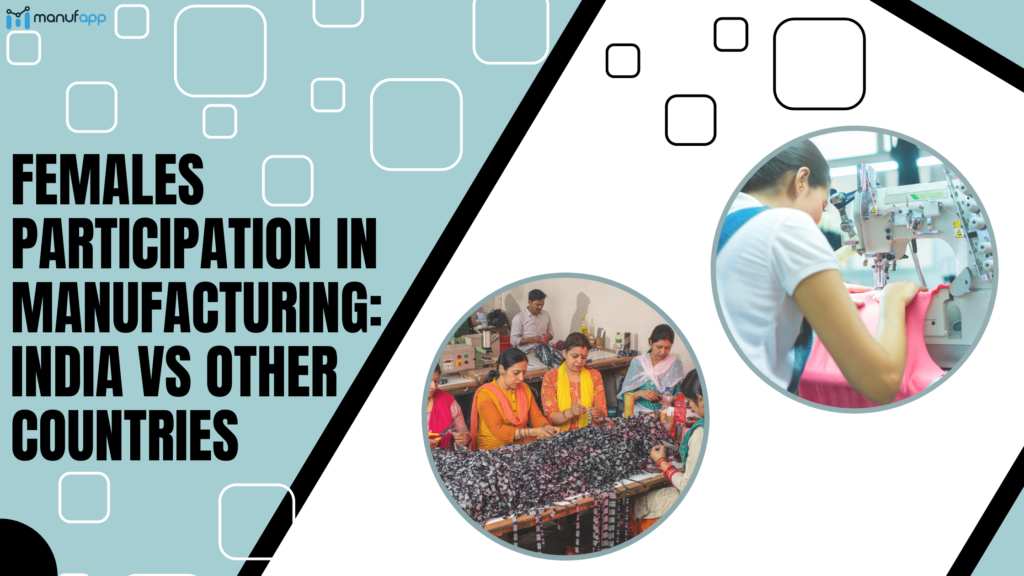The manufacturing industry is one of the largest employers in India, providing millions of jobs across the country. However, despite the growing demand for skilled workers, women continue to be underrepresented in this sector. In this blog post, we will delve into the current scenario of female participation in the Indian manufacturing industry and compare it with other countries like Bangladesh, China, Thailand, and Vietnam. We will analyze policies affecting female participation and discuss how these countries have successfully increased gender diversity in their manufacturing industries. By the end of this post, you will develop a better understanding of female participation in manufacturing and gain insights on what India can do to close the gender gap in this sector.
The current scenario of female participation in the manufacturing sector
Across different countries, the level of female labor force participation in the manufacturing sector varies significantly. Historically, this sector has been predominantly male-dominated, with limited opportunities for women. However, there has been a concerted effort to promote gender equality in the workforce, including the manufacturing industry. Despite these efforts, social norms and gender gaps continue to pose challenges to female participation in manufacturing.
To address this issue, various programs and initiatives have been implemented to increase female participation. These include promoting self-employment among women, providing support for women’s work in the manufacturing sector, and creating opportunities for women in labor markets. Additionally, in light of the COVID-19 pandemic, there has been a greater focus on ensuring women’s participation in the workforce and their access to social security and empowerment.
In different regions and countries, such as North Africa, Sub-Saharan Africa, Latin America, and high-income countries in Europe, substantial increases in women’s participation in manufacturing have been observed. For example, in Rwanda, the percentage of women workers in the manufacturing sector has seen remarkable growth. Furthermore, the United Nations and the International Labour Organization have emphasized the importance of women’s participation in the manufacturing sector for economic development and reducing gender inequalities.
The data from *World Bank, shows the Labour Force participation of females accessed on April 25, 2023.
***In Pakistan, working with the International Labour Organization (ILO), UN Women has mobilized women’s advocates to lobby for the country’s first Home-Based Workers Policy, designed to open women’s access to finance and markets, and ease the path to better work and incomes.
***UN Women leads a joint UN program on gender equality in Ethiopia that provides financial support to the Federal Micro and Small Enterprises Agency, along with training on subjects such as value chains, business development and green business incubators. The agency, in turn, has trained more than 6,000 women in marketing and business management; 8,000 women have used expanded credit and savings services to start and build businesses.
In summary, the current scenario of female participation in the manufacturing sector shows both progress and challenges. While there have been initiatives and programs to promote gender equality in this industry, social norms and gender gaps persist. However, experiences from countries with successful strategies can serve as valuable lessons for India and other regions to enhance female participation in manufacturing.
Comparing female participation in the manufacturing industry: India vs Bangladesh
In India, the manufacturing industry has historically been dominated by male workers. However, efforts have been made to increase female participation in this sector. Several factors have contributed to a relatively low level of female employment in manufacturing, including societal norms, safety concerns, and lack of proper infrastructure. Women have often been concentrated in labor-intensive and lower-skilled roles.
The Indian government and various organizations have initiated programs and policies to promote women’s participation in manufacturing, such as skill development initiatives, vocational training, and promoting entrepreneurship among women. Over the years, there has been a gradual increase in female participation, but significant gender disparities still persist.
Whereas, Bangladesh has seen significant growth in its manufacturing industry, particularly in sectors like textiles and garments. In this industry, female participation has been relatively high compared to other manufacturing sectors in the region. The ready-made garment (RMG) sector, in particular, has played a pivotal role in employing a large number of women.
The RMG industry in Bangladesh has been a major driver of economic growth and women’s empowerment. Many women from rural areas have moved to urban centers for employment in garment factories, contributing to their financial independence and social mobility. However, challenges related to working conditions, safety, and labor rights have also been highlighted in the Bangladeshi manufacturing industry.
Comparing female participation in the manufacturing industry: India vs China
China and India, two of the world’s most populous countries, have significant differences in female participation in the manufacturing industry. China leads the way with a higher percentage of women in manufacturing compared to India. This can be attributed to the implementation of policies aimed at increasing women’s participation in the labor force. In contrast, India has witnessed a recent surge in female labor force participation, but still lags behind China.
Various factors influence the disparity between the two countries. Cultural norms play a significant role, as they shape societal perceptions of women’s work and their roles in the labor force. Additionally, economic development also impacts female participation, with more developed countries usually exhibiting higher levels of participation.
Both China and India recognize the importance of women’s participation in the manufacturing industry. They understand that empowering women through self-employment opportunities and programs not only benefits individual women but also contributes to overall economic growth.
How does the female ratio in manufacturing differ between India and Thailand?
Thailand has shown relatively higher levels of female participation in its manufacturing sector. The country has a diverse industrial base, including electronics, automobiles, textiles, and food processing. In certain manufacturing segments, particularly electronics and textiles, women have played a significant role in the labor force. The garment and textile industry, similar to Bangladesh, has been a major employer of female workers.
Thailand’s manufacturing sector has benefited from the influx of women workers from rural areas seeking employment opportunities in urban centers. Factors such as favorable labor policies, relatively better working conditions, and a well-developed export-oriented manufacturing industry have contributed to higher female participation compared to some other countries in the region.
In summary, Thailand has generally experienced higher female participation in its manufacturing industry compared to India. However, specific statistics and trends might have changed since my last update, so I recommend consulting more recent sources for the latest information on female participation in the manufacturing sectors of both countries.
Comparing female participation in the manufacturing industry: India vs Vietnam
In comparing female participation in the manufacturing industry between India and Vietnam, it is evident that Vietnam has a higher percentage of women working in this sector compared to India. This can be attributed to the policies that Vietnam has implemented to promote women’s participation in the labor force. On the other hand, India has seen a recent increase in female labor force participation, indicating progress in this area.
Several factors contribute to the differences in female participation in manufacturing between the two countries. Education, cultural norms, and economic development play significant roles in shaping women’s work opportunities. Both India and Vietnam recognize the importance of women’s contribution to the manufacturing sector and have put in place measures to support their empowerment and inclusion.
It is interesting to note the varying dynamics of female participation in manufacturing across different regions and countries. While Vietnam stands out in Asia, countries in North Africa and Sub-Saharan Africa also show substantial increases in women’s labor force participation. Globally, there is increasing recognition of the crucial role that women play in labor markets and the need to create inclusive and supportive environments for their employment.
The contribution of females to the manufacturing sector in India
In the manufacturing sector in India, women play a significant role in contributing to its growth and development. Over the years, there has been an increase in female labor force participation, highlighting the valuable contribution of women to the industry. They have demonstrated their abilities and skills in various manufacturing roles, showcasing their potential as valuable assets in this sector. India recognizes the importance of empowering women in the workforce and acknowledges their significant contributions to the manufacturing sector. By providing opportunities for self-employment and implementing programs that promote women’s participation, India aims to further enhance their role in the manufacturing industry. This has led to a substantial increase in women workers in this sector, positively impacting the country’s GDP. As the country continues to work towards gender equality and empowerment, the manufacturing sector in India is set to witness even greater contributions from women. With reference to an article on **The Wire of the 8 million workers employed in India’s formal manufacturing industries in 2019-20, 1.6 million (19.7%) were women, data from the Annual Survey of Industries (ASI) shows.
Policies affecting female participation in manufacturing in India and other countries
Policies play a crucial role in influencing female participation in the manufacturing sector, not only in India but also in other countries. In India, there have been several initiatives implemented to encourage women’s involvement in manufacturing. Similarly, other nations have introduced policies to promote gender equality and women’s participation in the labor force.
Provisions such as maternity leave and childcare facilities have been established to support female workers in both India and other countries. Governments are actively working towards creating a conducive environment for women in manufacturing. These efforts aim to ensure that women have equal opportunities and can contribute effectively to the sector.
It is important to note that policies impacting female participation vary across different regions. For instance, countries in North Africa and sub-Saharan Africa have implemented programs to enhance women’s work in the manufacturing industry. On the other hand, high-income countries in Europe and Latin America have focused on empowering women in labor markets through various initiatives.
Overall, policies addressing female participation in manufacturing are essential for creating a more inclusive and diverse workforce. By providing support, opportunities, and equal rights, governments can significantly increase women’s presence and contribution to the sector.
What can India learn from these countries to increase female participation in manufacturing?
India can draw valuable lessons from the experiences of other countries that have successfully increased female participation in the manufacturing industry. While each country’s context is unique, several strategies and approaches have proven effective in promoting gender equality and increasing women’s participation in the workforce. Here are some lessons that India could consider:
Promote Skill Development and Training: Countries like Germany have established robust vocational training systems that provide women with the necessary skills to excel in manufacturing. India could invest in similar programs that offer women targeted training to access higher-skilled manufacturing jobs.
Provide Safe and Supportive Work Environments: Bangladesh’s ready-made garment industry has faced criticism for poor working conditions, but other countries have successfully created safe and supportive workplaces for women. India should prioritize worker safety, ensure fair wages, and implement policies that address gender-based harassment and discrimination.
Implement Family-Friendly Policies: Countries like Sweden and Norway have strong family-friendly policies, such as generous parental leave and affordable childcare options. Implementing such policies in India can help alleviate the burden of caregiving responsibilities that often hinder women’s participation in the workforce.
Flexible Work Arrangements: Countries like the Netherlands have embraced flexible work arrangements that allow employees to balance work and family commitments. Introducing flexible hours, remote work options, and part-time opportunities can attract more women to the manufacturing sector.
Equal Pay and Career Advancement: Addressing the gender pay gap and providing equal opportunities for career advancement are crucial. India could learn from countries like Iceland and the United Kingdom, which have taken legislative and organizational measures to ensure pay equity and representation of women in leadership roles.
Role Models and Mentorship: Establishing mentorship programs and showcasing successful women in manufacturing can inspire and encourage younger generations to pursue careers in the sector. Countries like Japan have initiated initiatives to promote role models and mentorship for women in traditionally male-dominated fields.
Promote Entrepreneurship: Encouraging women to start their own manufacturing businesses can boost female participation. India could adopt policies similar to those in Rwanda, where women entrepreneurs receive support, training, and funding to establish and grow their businesses.
Education and Awareness: Raising awareness about the benefits of women’s participation in manufacturing and challenging societal norms that discourage women from pursuing certain careers is essential. Countries like South Korea have launched campaigns to challenge gender stereotypes and promote women’s participation in STEM fields, which can be applied to manufacturing as well.
Government Policies and Incentives: Governments can play a crucial role in incentivizing companies to hire and retain women in the manufacturing sector. Tax incentives, subsidies, and quotas for women’s employment can encourage companies to prioritize gender diversity.
Collaboration with Industry and NGOs: Collaborating with industry associations and non-governmental organizations (NGOs) can help create a supportive ecosystem for women in manufacturing. Programs that offer mentorship, training, and networking opportunities can bridge the gender gap.
It’s important to adapt these lessons to India’s cultural, economic, and social context. A holistic approach that involves government, businesses, civil society, and educational institutions can contribute to meaningful progress in increasing female participation in the Indian manufacturing industry.
Conclusion
In conclusion, it is evident that female participation in the manufacturing sector varies significantly between countries. While some countries like Bangladesh and China have made strides in increasing female participation, India still lags behind. It is crucial for India to learn from these countries and implement policies that promote gender equality and inclusivity in the manufacturing sector. By providing equal opportunities, addressing gender biases, and offering support systems, India can empower more women to join the manufacturing workforce. This not only benefits individual women but also contributes to the overall growth and development of the country’s economy. It is high time that India recognizes the potential of its female workforce and takes steps to harness it for a brighter future.
*https://data.worldbank.org/indicator/SL.TLF.CACT.FE.ZS
***https://www.unwomen.org/en/what-we-do/economic-empowerment/employment-and-migration





